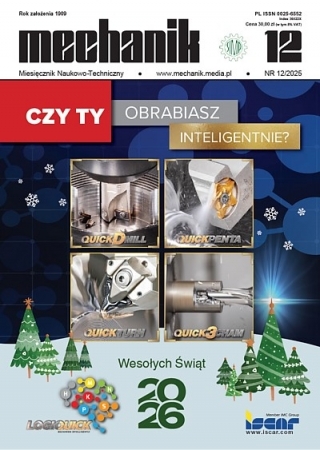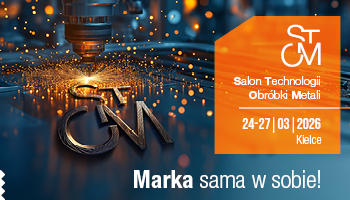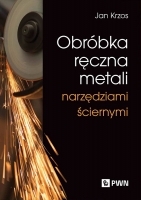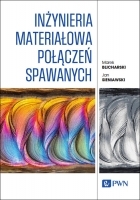Identyfikacja parametrów procesu selektywnego stapiania laserowego stopu CoCr na podstawie wybranych parametrów topografii powierzchni po frezowaniu
Identification of parameters of selective laser melting process of the CoCr alloy on the basis of assorted parameters of topography of a surface after milling
Mechanik nr 08/09/2015 - Wersje autorskie artykułów z IX Konferencji Szkoły Obróbki Skrawaniem zamieszczone na płycie CD
STRESZCZENIE: Artykuł prezentuje przebieg i wyniki badań nad określeniem zależności pomiędzy parametrami procesu selektywnego stapiania laserowego SLM (selective laser melting) stopu CoCr a wybranymi parametrami topografii powierzchni po frezowaniu. Stop CoCr jest materiałem szeroko wykorzystywanym w medycynie, a zwłaszcza w dentystyce i protetyce. Jest powszechnie stosowany w technologiach przyrostowych, takich jak selektywne stapianie laserowe, i pozwala na wytwarzanie elementów o niemal dowolnie złożonej geometrii. Powstałe w ten sposób np. implanty można w bardzo wysokim stopniu spersonalizować. Ważnym aspektem jes również brak konieczności stosowania dodatkowego oprzyrządowania technologicznego, które znacznie podwyższa koszt produkcji jednostkowej, jaką jest wytwarzanie spersonalizowanych implantów medycznych. Jedną z największych wad technologii SLM jest wysoka chropowatość surowej powierzchni oraz niedostateczna dokładność wymiarowo-kształtowa. Pomimo że nad poprawą tych parametrów prowadzone są obecnie intensywne badania, a ich efekty są coraz lepsze, to zazwyczaj w celu uzyskania w pełni funkcjonalnych implantów zachodzi konieczność wykorzystania obróbki skrawaniem. Wcześniejsze badania pokazały, że w zależności od parametrów procesu SLM przedmioty wytworzone ze stopu CoCr mogą mieć zróżnicowane właściwości mechaniczne. Różnice te są widoczne zwłaszcza podczas obróbki skrawaniem. Prezentowane w artykule wyniki badań mają dać odpowiedź na pytanie, w jaki sposób dobór parametrów procesu SLM może wpływać na topografię powierzchni otrzymaną po procesie frezowania.
SŁOWA KLUCZOWE: selektywne spiekanie laserowe, frezowanie
ABSTRACT: The article presents the course and results of a study intended to determine the correlation between the parameters of the process of selective laser melting (SLM) of the CoCr alloy and assorted parameters of topography of a surface after milling. The CoCr alloy is a material widely used in medicine, particularly in dentistry and prosthetics. It is universally used in incremental technologies, such as selective laser melting, and allows manufacturing of elements with almost any complex geometries. Products made in such a manner, e.g. implants, enable a very large degree of customization. Another important aspect is the lack of necessity to use additional technological accessories significantly increasing the cost of unit production which is manufacturing of customized medical implants. One of the greatest disadvantages of the SLM technology is high roughness of the raw surface and insufficient dimensional and form accuracy. Although intense research is currently conducted in order to improve these parameters, and the effects thereof are increasingly better, there is usually a necessity to apply machining in order to obtain fully functional implants. The previous research has demonstrated that depending on the parameters of the SLM process, objects made of the CoCr alloy may have diverse mechanical properties. These differences are particularly visible during machining. The research results, as presented in the article, are to answer the question how the selection of parameters of the SLM process may impact the surface topography obtained after the process of milling.
KEYWORDS: selective laser melting, milling
BIBLIOGRAFIA / BIBLIOGRAPHY:
- Osakada K., Shiomi M., 2006, ‘Flexible manufacturing of metallic products by selective laser melting of powder’, International Journal of Machine Tools & Manufacture, vol. 46, pp. 1188-1193
- Monroy K., Delgado J., Ciurana J., 2013, ‘Study of the pore formation on CoCrMo alloys by selective laser melting manufacturing process’, Procedia Engineering, vol. 63, pp. 361-369
- Wang D., Yang Y., Liu R., Xiao D., Sun J., 2013, ‘Study on the designing rules and process stability of porous structure based on selective laser melting (SLM)’, Journal of Materials Processing Technology, vol. 213, pp. 1734-1742
- Hagedorn Y-C., Wilkes J., Meiners W., Wissenbach K., Poprawe R., 2010, ‘Net Shaped High Performance Oxide Ceramic Parts by Selective Laser Melting’, Physics Procedia, vol. 5, pp. 587-594
- Su X., Yang Y., 2012, ‘Research on track overlapping during Selective Laser Melting of powder’, Journal of Materials Processing Technology, vol. 212, pp. 2074-2079
- Xin X-Z., Chen J., Xiang N., Gong Y., Wei B., 2014, ’Surface characteristics and corrosion properties of selective laser melted Co–Cr dental alloy after porcelain firing’, Dental Materials, vol. 30, pp. 263-270
- Rombouts M., Kruth J.P., Froyen L., Mercelis P., 2006, ‘Fundamentals of Selective Laser Melting of alloyed steel powders’, CIRP Annals – Manufacturing Technology, vol. 55 (1), pp. 187-192
- Yamanaka K., Mori M., Kuramoto K., Chiba A., 2014, ‘Development of new Co–Cr–W-based biomedical alloys: Effects of microalloying and thermomechanical processing on microstructures and mechanical properties’, Materials and Design, vol. 55, pp. 987–998
- Al. Jabbari Y.S., Koutsoukis T., Barmpagadaki X., Zinelis S., 2014, ‘Metallurgical and interfacial characterization of PFM Co–Cr dental alloys fabricated via casting, milling or selective laser melting’, Dental Materials, vol. 30, pp. e79-e88
- Biedunkiewicz A., Figiel P., Biedunkiewicz W., Grzesiak D., Krawczyk M., Gabriel-Polrolniczak U., 2014, ‘Mechanical Properties of Metal Matrix Nanocomposites Synthesized by Selective Laser Melting Measured by Depth Sensing Indentation Technique’, Key Engineering Materials, vol. 586, pp. 83-86
- Figiel P., Biedunkiewicz W., Grzesiak D., 2012, ‘Oxidation process of the steel/nc-TiC nanocomposites’ Journal of Thermal Analysis and Calorimetry, vol. 108, pp. 979-983
- Biedunkiewicz A., Biedunkiewicz W., Figiel P., Grzesiak D., Jaworska M., 2012, ‘Nanokompozyty wytwarzane metodą selektywnego stapiania/spiekania umocnione nanokrystalicznymi proszkami w układzie Fe-Ti-BC’, Inzynieria Materiałowa, vol. 33(6)
- Biedunkiewicz A., Biedunkiewicz W., Figiel P., Grzesiak D., 2011, ‘Preparation of stainless steel-TiC composite by selective laser melting’, Chemicke Listy, vol. 105, pp. 773-774
- Xiang N., Xin X-Z., Chen J., Wei B., 2012, ‘Metal–ceramic bond strength of Co–Cr alloy fabricated by selective laser melting’ Journal of Dentistry, vol. 40, pp. 453–457
- Joo B-D., Jang J-H., Lee J-H., Son Y-M., Moon Y-H, 2009, ‘Selective laser melting of Fe-Ni-Cr layer on AISI H13 tool steel’ Transactions of Nonferrous Metals Society of China, vol. 19, pp. 921-924
- Xin X.Z., Xiang N., Chen J., Wei B., 2012, ‘In vitro biocompatibility of Co–Cr alloy fabricated by selective laser melting or traditional casting techniques’, Materials Letters, vol. 88, pp. 101-103
- Xiang N., Xin X-Z., Chen J., Wei B., 2012, ‘Metal–ceramic bond strength of Co–Cr alloy fabricated by selective laser melting’ Dental Materials, vol. 40, pp. 453-457
- http://www.sandvik.coromant.com/pl-pl/knowledge/materials/workpiece_materials/iso_s_hrsa_titanium/pages/default.aspx
- D. Grzesiak, M. Krawczyk: Effects of the Selective Laser Melting Process Parameters on the Functional Properties of the Co-Cr Alloy. International Journal of Recent Contributions from Engineering, Science & IT (iJES) ‒ Volume 3, Issue 1: "ICAT 2014", 2015
- Mathia T., Pawlus P., Wieczorowski M.: „Recent trends in surface metrology”. 2011 Wear 271, s.494–508.
- ISO 25178-2, Geometrical product specifications (GPS) — Surface texture: Areal — Part 2: Terms, definitions and surface texture parameters





















